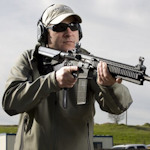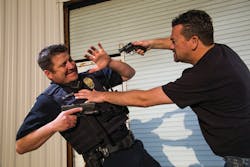The Deadliest Distance
15 Tips for Close Quarter Shooting
By Richard Nance
Photos by Alfredo Rico
“Another shoplifter. Third one this week”, you recall as you grab the seemingly compliant suspect by the arm and unsnap your cuff case. Just then, he spins and reaches frantically into his waistband. In a flash of steel, you’re starring down the barrel of a gun.
Sound unlikely? Think it can’t happen to you? Think again…
According to the FBI's 2012 Law Enforcement Officers Killed and Assaulted report, 24 of the 44 officers killed with firearms were between zero and five feet from the offender when shot. Despite this indisputable data, most officers receive far too little training from this faced-paced, hyper-violent range of combat.
While one might assume close distance translates to easier hits with a handgun, that’s not necessarily the case when you’re facing a real adversary as opposed to one made of paper, wearing a scoring ring.
Many fail to account for the fact that when so close to your adversary, time frames are dramatically compressed and contact distance weapons like edged weapons and bludgeons come into play. Even an unarmed assailant would present a deadly threat if he managed to disarm you.
Although reading an article is no substitute for realistic and consistent training in this oft-neglected skill set, I've compiled 15 tips that might serve as the foundation upon which you can develop your own close quarter shooting regimen. Here's my list, in no particular order.
- Forget the “Speed Rock”
This decades-old technique was developed to create enough space to draw your gun in response to a close quarter threat. The problem with the “Speed rock” is that leaning your upper body away from the threat inherently compromises your balance.
- Be aggressive!
In close confines, aggressiveness often trumps technique. Think of running over the suspect. Make him “Speed rock”! Not only will this disrupt the suspect’s balance, it will shift his focus from hurting you to not getting hurt himself.
- Address the suspect’s weapon first
When an armed suspect has the drop on you, trying to immediately draw your gun is ill-advised. If you don’t believe me, familiarize yourself with the work of Dennis Tueller. In close quarters, you must address the suspect’s weapon first.
- Be proficient in counter-weapon tactics
Thanks to the Action vs. Reaction principle, it is quite possible to get out of the line of fire and control a suspect’s gun before he can pull the trigger. You may even be able to actually take the gun away from him. Disarming an edged weapon in motion, on the other hand, is far less likely. A more realistic option is to protect your head and neck as you drive the suspect onto his heels. From there, disengage and draw your gun.
- Be able to aim without seeing your sights
In a deadly force encounter at arm’s length, you won’t have the luxury of bringing your gun up to eye level. Doing so, would leave you susceptible to being disarmed. By indexing your gun to your chest in a consistent manner, you can use your body to aim.
- Learn to shoot from retention
As the suspect closes in, you need to retract your gun to prevent him from grabbing it. A two-handed close quarter shooting position affords optimal leverage but ties up both hands. The one-handed close quarter hold, with your gun hand anchored to your body aids in gun retention and leaves you a free hand with which to fight or fend. Due to the orientation of your muzzle when shooting from the one-handed close quarter hold, your rounds will impact low.
- Use your off-hand to fight or fend
Initially bringing your off-hand to your chest makes sense when drawing to two-handed, eye-level shooting position, but doing so leaves you vulnerable in a close quarter gunfight. You would be better served using your off-hand to strike under the suspect’s chin to drive him back or to protect yourself from incoming strikes, as the situation dictates.
- Know where your trigger finger is
If your gun is in-hand and a suspect charges you, shooting him might not be reasonable. In a close quarter confrontation, trigger finger placement must be a conscious decision. If your finger is on the trigger when it shouldn’t be, clutching with your off-hand or losing your balance could result in an unintended discharge with tragic consequences.
- Know how to use your gun as an impact weapon
Even an empty or inoperable gun can be an effective weapon. Strike with the muzzle or the bottom of the magazine to ensure the business end is facing away from you. If your gun is operable, using it as an impact weapon could result in an unintended discharge.
- Consider a weapon mounted pistol light that protrudes beyond the muzzle
Not only does a robust pistol light enable you to see and disrupt a suspect’s vision, if it protrudes beyond the muzzle, it may provide a gap between your muzzle and the suspect so you can fire multiple contact distance shots, a function typically associated only with a revolver.
- Be prepared to shoot while on the ground with the suspect
As a police officer, the last place you want to have to fight from is the ground. Studies have shown that when a suspect takes an officer to the ground, the assault is usually brutal and continuous. You need to know how to draw and shoot while fighting from the ground. Controlling whichever one of the suspect’s hands is closest to your gun is a good place to start.
- Retain your gun at all costs
Between 2003 and 2012, 43 officers were killed with their own guns. (Sadly, while writing this article, I received an email notification of yet another officer who was disarmed and killed). If the suspect goes for your gun, all bets are off!
- When you disengage, Tap, Rack, and Assess
There’s a good chance a tug of war over your pistol will render it out of battery so it’s wise to tap the magazine to ensure it is properly seated, rack the slide to chamber a round, then assess to determine if firing is warranted.
- Don't forget to scan for additional threats
Stay focused on the immediate threat until it is neutralized. Then, move your head to overcome the “tunnel vision” effect, as you scan for additional threats.
- Never give up!
Sure, technical proficiency is a critical factor in the outcome of a close quarter shooting but it pales in comparison to your willingness to do whatever it takes to win. No matter how dire the situation, you must believe that you will prevail!
As police officers, we don't always dictate where the fight takes place. But it is our duty to become proficient at fighting from what has proven year after yea to be the most deadly range of combat. So, grab an inert training gun, find a partner, and see what works for you against an animated adversary who’s trying to make you fail. Then, next time you’re at the range, focus on developing your close quarter shooting repertoire. One day, your life could depend on it.
***Link to Hi-res images:
http://www.defensephotos.com/client/rico-NANCE.zip
***Refer to attached photo caption sheet

Richard Nance
Richard Nance is a veteran police officer and former SWAT team leader. He is the co-owner of WARTAC, a company that provides training in firearms, tactics, and personal defense. Nance cohosts Handguns & Defensive Weapons, a new television series on the Sportsman Channel.



